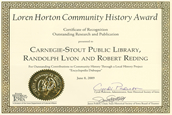Encyclopedia Dubuque
"Encyclopedia Dubuque is the online authority for all things Dubuque, written by the people who know the city best.”
Marshall Cohen—researcher and producer, CNN
Affiliated with the Local History Network of the State Historical Society of Iowa, and the Iowa Museum Association.
SWIFT AND COMPANY: Difference between revisions
No edit summary |
No edit summary |
||
| Line 10: | Line 10: | ||
[[Image:swifttruckfleet.jpg|left|thumb|450px|Photo courtesy: Paul Hemmer]] | [[Image:swifttruckfleet.jpg|left|thumb|450px|Photo courtesy: Paul Hemmer]] | ||
My father, Andy Hemmer, was the head mechanic for Swift & Company in the early 1930s when they were in Dubuque. The plant, dealing mostly with chickens, was located where the [[JULIEN DUBUQUE BRIDGE]] now exists. Dad is the only image on the photo I know. He's wearing the leather jacket. | My father, Andy Hemmer, was the head mechanic for Swift & Company in the early 1930s when they were in Dubuque. The plant, dealing mostly with chickens, was located where the [[JULIEN DUBUQUE BRIDGE]] now exists. Dad is the only image on the photo I know. He's wearing the leather jacket. | ||
Revision as of 17:54, 9 September 2018
SWIFT AND COMPANY. During the 1850s, when he was still a teenager, Gustavus F. Swift began working in the beef business in Massachusetts.
In 1875, Swift began buying cattle in Chicago to send to his family's butcher operations back East. He revolutionized the meat industry by using newly developed refrigerated railcars to ship fresh meat from Chicago to Eastern markets. The company soon set up a national network of branch offices, which allowed it to control the distribution of its meat across the country. By 1886, when the company slaughtered more than 400,000 cattle a year, Swift employed about 1,600 people.
Between 1887 and 1892, new packing plants were opened in Kansas City, Omaha, and St. Louis. By the time the founder died in 1903, his company grossed $200 million in annual sales and employed about 23,000 people across the country, including over 5,000 workers at its slaughtering plant in Chicago's Union Stock Yard. In 1908, Swift plants across the country slaughtered a total of about eight million animals. By this time, Swift owned a fleet of nearly 5,000 refrigerated railcars.
Annual sales reached $700 million by the late 1920s, when the total workforce of the company—which ranked as one of the largest industrial corporations in the United States—consisted of about 55,000 people. Swift stopped slaughtering in Chicago in 1953, but its corporate headquarters remained in the city.
In 1973, by which time meat had become only one of its businesses, Swift became part of Esmark Inc., a holding company. During the 1980s, Esmark's meat division was spun off and moved to Texas. From the early 1990s through the early 2000s, food conglomerate Conagra owned Swift's operations. Swift & Company's divisional headquarters were located in Greeley, Colorado.
My father, Andy Hemmer, was the head mechanic for Swift & Company in the early 1930s when they were in Dubuque. The plant, dealing mostly with chickens, was located where the JULIEN DUBUQUE BRIDGE now exists. Dad is the only image on the photo I know. He's wearing the leather jacket.
The 1911-12 Dubuque City Directory listed 575 6th.
The 1922 Dubuque Telephone Directory listed 22 S. Locust.
The 1929 Dubuque City Directory listed 698 White for this wholesaler.
The 1939 and 1941 Dubuque City Directory listed 26 S. Locust for this hatchery.
The 1945 and 1951 Dubuque City Directory listed 30 S. Locust.
---
Source:
Paul Hemmer, e-mail, November, 2010
Swift and Company--encyclopedia.chicagohistory.org/pages/2869.html
Swift and Company--encyclopedia.chicagohistory.org/pages/2869.html



